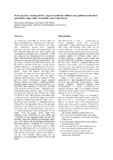Shrimp pond effluents and water quality in Imbang River, Negros Occidental
| dc.contributor.author | Taberna, Evelyn T. | |
| dc.contributor.editor | Bagarinao, Teodora | |
| dc.date.accessioned | 2018-02-23T03:42:42Z | |
| dc.date.available | 2018-02-23T03:42:42Z | |
| dc.date.issued | 2007 | |
| dc.identifier.citation | Taberna, E. T. (2008). Shrimp pond effluents and water quality in Imbang River, Negros Occidental. In T. U. Bagarinao (Ed.), Research Output of the Fisheries Sector Program (Vol. 2. Reports on Fisheries and Aquaculture, pp. 60-70). Quezon City, Philippines: Bureau of Agricultural Research, Department of Agriculture. | en |
| dc.identifier.isbn | 9718511776 | |
| dc.identifier.uri | http://hdl.handle.net/10862/3265 | |
| dc.description.abstract | The contribution of shrimp farm effluents to the pollution load in Imbang River, Negros Occidental was measured during the period May 1993 to February 1995. Shrimp pond effluents were characterized and the pollution load estimated. The pond effluents had low average nitrite (0.0025 ppm) and nitrate (0.06 ppm) and optimum (for shrimp culture) pH 7.9, phosphate 0.15 ppm, dissolved oxygen 5.20 ppm, and salinity 23.3 ppt. Ammonia was 0.13 ppm on average in most farms, above the safe level for shrimp, and total suspended solids was 23 ppm, about 2.5x the allowed limit for effluents. Biochemical oxygen demand (20 ppm) and settleable solids (0.15 ppm) were still with acceptable limits. Residues of organochlorine pesticides were present at very low concentrations, well below the safe levels for aquatic life. Most of the pollution load came from the regular water exchanges over the 4-month crop cycle, at least every two weeks in low-density farms and more frequently in the high-density farms. The total draining of pond water at harvest contributed a minor load. Total solids from shrimp farms contributed a huge load, about 181,325 mt/yr. Total suspended solids contributed 1,285 mt/yr and settleable solids <1 mt/yr. The total BOD load was 154,367 kg/yr. The phosphate load was about 1,080 kg/yr, and the total nitrogen load was 1,225 kg/yr. The effects of effluent release from farms were localized. Upstream water quality and other uses of the river were not affected. Since most of the shrimp farms were located 1.5–2 km from the sea, the release of effluents during water exchange and at harvest did not adversely affect water quality downstream of these farms. Where such draining increased the levels of ammonia, phosphate, and total suspended solids in the river, the effect was significant only within 250 m from the release point, and the pollutants were dissipated about 550–800 m downstream The other water quality variables were at low levels in the pond effluents and did not affect the river water during draining. Often the concentrations of pollutants in the river were higher before than during draining of pond effluents. Stations upstream of the release sites of pond effluents often had high pollutant concentrations from other upstream sources. | en |
| dc.language.iso | en | en |
| dc.publisher | Bureau of Agricultural Research, Department of Agriculture | en |
| dc.subject | Philippines | en |
| dc.title | Shrimp pond effluents and water quality in Imbang River, Negros Occidental | en |
| dc.type | Book chapter | en |
| dc.citation.spage | 60 | |
| dc.citation.epage | 70 | |
| dc.citation.bookTitle | Research Output of the Fisheries Sector Program | en |
| dc.subject.asfa | aquaculture effluents | en |
| dc.subject.asfa | water quality | en |
| dc.subject.asfa | agricultural pollution | en |
| dc.subject.asfa | aquaculture enterprises | en |
| dc.subject.asfa | environmental impact | en |
| dc.subject.asfa | water masses | en |
| dc.subject.asfa | aquaculture | en |
| dc.subject.asfa | shrimp culture | en |
| dc.subject.asfa | pesticide residues | en |
| dc.subject.asfa | ammonia | en |
| dc.subject.asfa | dissolved oxygen | en |
| dc.subject.asfa | biochemical oxygen demand | en |
| dc.subject.asfa | suspended particulate matter | en |
Files in this item
| Files | ขนาด | รูป | View |
|---|---|---|---|
|
There are no files associated with this item. |
|||



